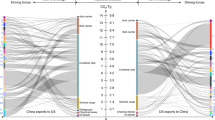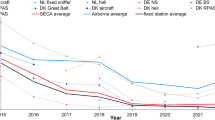Abstract
The maritime industry boosts the prosperity of port cities but also exacerbates premature death associated with air pollution. In recent years, Chinese port cities have undergone profound multifaceted transformations on emissions control and demographic characteristics, leading to an unclear relationship between shipping emissions and health burden. Here we built a comprehensive evaluation framework to investigate the impacts of ships in Chinese port cities from 2016 to 2020. We found shipping-related fine particulate matter (PM2.5) decreased across all port cities under shipping sulfur emissions control. However, nationwide shipping-related mortality associated with long-term PM2.5 exposure increased by 11.4% to 48,300 deaths in 2020. A trend of mitigation was observed in coastal cities, but a trend of aggravation in port cities along inland rivers due to varying antagonisms between shipping emissions reductions and regional demographic changes. Population clustering in port cities necessitates further locality-specific control of shipping emissions.
This is a preview of subscription content, access via your institution
Access options
Subscribe to this journal
Receive 12 digital issues and online access to articles
$119.00 per year
only $9.92 per issue
Buy this article
- Purchase on Springer Link
- Instant access to full article PDF
Prices may be subject to local taxes which are calculated during checkout





Similar content being viewed by others
Data availability
Data supporting the main findings in this study are available at https://doi.org/10.5281/zenodo.10643061. The ship automatic identification system big data and ship technical specifications database are restricted to third parties and used under license for this study. The shipping emissions data are available from the corresponding author upon request. The other emissions data are publicly available, with details described in Supplementary Table 1. The population data and cross-sectional mortality rate are publicly available, with details described in Supplementary Information section ‘Excess mortality estimation’.
Code availability
The codes associated with this paper involve Python version 3.7 and R version 4.2.2. Codes used during the current study are available from the corresponding author upon reasonable request.
References
Feng, J. et al. The influence of spatiality on shipping emissions, air quality and potential human exposure in the Yangtze River Delta/Shanghai, China. Atmos. Chem. Phys. 19, 6167–6183 (2019).
Liu, H. et al. Emissions and health impacts from global shipping embodied in US–China bilateral trade. Nat. Sustain. 2, 1027–1033 (2019).
Shi, Z. et al. Perspectives on shipping emissions and their impacts on the surface ocean and lower atmosphere: an environmental-social-economic dimension. Elem. Sci. Anth. 11, 00052 (2023).
Luo, Z. et al. Advancing shipping NOx pollution estimation through a satellite-based approach. PNAS Nexus 3, pgad430 (2023).
Contini, D. & Merico, E. Recent advances in studying air quality and health effects of shipping emissions. Atmosphere 12, 92 (2021).
Beard, J. R. et al. The World report on ageing and health: a policy framework for healthy ageing. Lancet 387, 2145–2154 (2016).
Zheng, B. et al. Trends in China’s anthropogenic emissions since 2010 as the consequence of clean air actions. Atmos. Chem. Phys. 18, 14095–14111 (2018).
Zhang, Q. et al. Drivers of improved PM2. 5 air quality in China from 2013 to 2017. Proc. Natl Acad. Sci. USA 116, 24463–24469 (2019).
Contini, D. et al. Inter-annual trend of the primary contribution of ship emissions to PM2.5 concentrations in Venice (Italy): efficiency of emissions mitigation strategies. Atmos. Environ. 102, 183–190 (2015).
Tao, L., Fairley, D., Kleeman, M. J. & Harley, R. A. Effects of switching to lower sulfur marine fuel oil on air quality in the San Francisco Bay Area. Environ. Sci. Technol. 47, 10171–10178 (2013).
Winebrake, J. J., Corbett, J. J., Green, E. H., Lauer, A. & Eyring, V. Mitigating the health impacts of pollution from oceangoing shipping: an assessment of low-sulfur fuel mandates. Environ. Sci. Technol. 43, 4776–4782 (2009).
Notice of the Ministry of Transport on printing and distributing the implementation plan of ship emission control zone in the waters of Pearl River Delta, Yangtze River Delta and Bohai Rim (Beijing Tianjin Hebei) [Chinese] (Ministry of Transport, 2015); https://www.gov.cn/xinwen/2015-12/04/content_5019932.htm
Notice of the Ministry of Transport on printing and distributing the implementation plan for the control area of air pollutant emission from ships [Chinese] (Ministry of Transport, 2018); https://www.gov.cn/zhengce/zhengceku/2018-12/31/content_5444672.htm
International Convention for the Prevention of Pollution from Ships (MARPOL): Adoption: 1973 (Convention), 1978 (1978 Protocol), 1997 (Protocol - Annex VI); Entry into force: 2 October 1983 (Annexes I and II). International Maritime Organization https://www.imo.org/en/About/Conventions/Pages/International-Convention-for-the-Prevention-of-Pollution-from-Ships-(MARPOL).aspx (2020).
Chen, Y. et al. Provincial and gridded population projection for China under shared socioeconomic pathways from 2010 to 2100. Sci. Data 7, 83 (2020).
Xu, F. et al. The challenge of population aging for mitigating deaths from PM2.5 air pollution in China. Nat. Commun. 14, 5222 (2023).
Wang, X.-Q. & Chen, P.-J. Population ageing challenges health care in China. Lancet 383, 870 (2014).
Cai, W. et al. The 2022 China report of the Lancet Countdown on health and climate change: leveraging climate actions for healthy ageing. Lancet Public Health 7, e1073–e1090 (2022).
Yuan, Y. et al. Diverse changes in shipping emissions around the Western Pacific ports under the coeffect of the epidemic and fuel oil policy. Sci. Total Environ. 879, 162892 (2023).
Wang, X. et al. Ship emissions around China under gradually promoted control policies from 2016 to 2019. Atmos. Chem. Phys. 21, 13835–13853 (2021).
Zhai, J. et al. Impact of ship emissions on air quality in the Greater Bay Area in China under the latest global marine fuel regulation. Environ. Sci. Technol. 57, 12341–12350 (2023).
Feng, X. et al. Impacts of ship emissions on air quality in Southern China: opportunistic insights from the abrupt emission changes in early 2020. Environ. Sci. Technol. 57, 16999–17010 (2023).
Zhou, F. et al. Influence of ship emission control area policy on air quality at Shanghai Port—local and regional perspectives. Ecol. Indic. 155, 110951 (2023).
Chen, C., Saikawa, E., Comer, B., Mao, X. & Rutherford, D. Ship emission impacts on air quality and human health in the Pearl River Delta (PRD) region, China, in 2015, with projections to 2030. GeoHealth 3, 284–306 (2019).
Zhang, Y. et al. Shipping emissions and their impacts on air quality in China. Sci. Total Environ. 581–582, 186–198 (2017).
Huang, H. et al. Inland ship emission inventory and its impact on air quality over the middle Yangtze River, China. Sci. Total Environ. 843, 156770 (2022).
Sirimanne, S. N. et al. Review of Maritime Transport 2019 (United Nations Conference on Trade and Development, 2019).
Zheng, Z. & Yang, G. in Contemporary Demographic Transformations in China, India and Indonesia (eds Guilmoto, C. Z. & Jones, G. W.) 223–237 (Springer, 2016).
Wu, Z. et al. Dramatic increase in reactive volatile organic compound (VOC) emissions from ships at berth after implementing the fuel switch policy in the Pearl River Delta Emission Control Area. Atmos. Chem. Phys. 20, 1887–1900 (2020).
Lv, Z. et al. Source–receptor relationship revealed by the halted traffic and aggravated haze in Beijing during the COVID-19 lockdown. Environ. Sci. Technol. 54, 15660–15670 (2020).
Liu, H. et al. The impact of marine shipping and its DECA control on air quality in the Pearl River Delta, China. Sci. Total Environ. 625, 1476–1485 (2018).
Luo, L. et al. Changes in nitrate accumulation mechanisms as PM2.5 levels increase on the North China Plain: a perspective from the dual isotopic compositions of nitrate. Chemosphere 263, 127915 (2021).
Lv, Z. et al. Impacts of shipping emissions on PM2.5 pollution in China. Atmos. Chem. Phys. 18, 15811–15824 (2018).
Zhang, Y. Q. et al. Impact of anthropogenic emissions on biogenic secondary organic aerosol: observation in the Pearl River Delta, southern China. Atmos. Chem. Phys. 19, 14403–14415 (2019).
Gregoris, E. et al. Impact of maritime traffic on polycyclic aromatic hydrocarbons, metals and particulate matter in Venice air. Environ. Sci. Pollut. Res. 23, 6951–6959 (2016).
Castles, S. in Human Trafficking (eds Gutiérrez Chong, N. & Clark, J. B.) Ch. 1 (Routledge, 2017).
Dou, X. & Liu, Y. Elderly migration in China: types, patterns, and determinants. J. Appl. Gerontol. 36, 751–771 (2017).
Yin, C., He, Q., Liu, Y., Chen, W. & Gao, Y. Inequality of public health and its role in spatial accessibility to medical facilities in China. Appl. Geogr. 92, 50–62 (2018).
Cofala, J. et al. The Potential for Cost-effective Air Emission Reductions from International Shipping Through Designation of Further Emission Control Areas in EU Waters with Focus on the Mediterranean Sea (International Institute for Applied Systems Analysis, 2018).
Ramacher, M. O. et al. The impact of ship emissions on air quality and human health in the Gothenburg area–Part II: Scenarios for 2040. Atmos. Chem. Phys. 20, 10667–10686 (2020).
Karl, M. et al. Impact of a nitrogen emission control area (NECA) on the future air quality and nitrogen deposition to seawater in the Baltic Sea region. Atmos. Chem. Phys. 19, 1721–1752 (2019).
Al-Enazi, A., Okonkwo, E. C., Bicer, Y. & Al-Ansari, T. A review of cleaner alternative fuels for maritime transportation. Energy Rep. 7, 1962–1985 (2021).
Shore Power Technology Assessment at US Ports (United States Environmental Protection Agency, 2017).
Gillingham, K. T. & Huang, P. Long-run environmental and economic impacts of electrifying waterborne shipping in the United States. Environ. Sci. Technol. 54, 9824–9833 (2020).
Lelieveld, J., Evans, J. S., Fnais, M., Giannadaki, D. & Pozzer, A. The contribution of outdoor air pollution sources to premature mortality on a global scale. Nature 525, 367–371 (2015).
Burnett, R. T. et al. An integrated risk function for estimating the global burden of disease attributable to ambient fine particulate matter exposure. Environ. Health Perspect. 122, 397–403 (2014).
Cohen, A. J. et al. Estimates and 25-year trends of the global burden of disease attributable to ambient air pollution: an analysis of data from the Global Burden of Diseases Study 2015. Lancet 389, 1907–1918 (2017).
Tuomisto, J., Wilson, A., Evans, J. & Tainio, M. Uncertainty in mortality response to airborne fine particulate matter: combining European air pollution experts. Reliab. Eng. Syst. Saf. 93, 732–744 (2008).
Mallidis, I., Despoudi, S., Dekker, R., Iakovou, E. & Vlachos, D. The impact of sulphur limit fuel regulations on maritime supply chain network design. Ann. Oper. Res. 294, 677–695 (2020).
Acknowledgements
This work was supported by National Natural Science Foundation of China (grant nos. 42325505 and U2233203) to H.L., National Key Research and Development Program of China (grant no. 2022YFC3704200) to H.L. and the Tsinghua University-Toyota Research Center.
Author information
Authors and Affiliations
Contributions
Z. Luo, Z. Lv and H.L. designed the research. Z. Luo and Z. Lv performed the air quality and mortality estimation model. J.Z., H.S., T.H., W.Y. and Z.Z. performed the analyses and visualization. H.L. and K.H. provided insights into the scenario design. All authors contributed to the writing.
Corresponding author
Ethics declarations
Competing interests
The authors declare no competing interests.
Peer review
Peer review information
Nature Cities thanks Daniele Contini, Elen Twrdy and the other, anonymous, reviewer(s) for their contribution to the peer review of this work.
Additional information
Publisher’s note Springer Nature remains neutral with regard to jurisdictional claims in published maps and institutional affiliations.
Supplementary information
Supplementary Information
Supplementary results, methods, Figs. 1–17, Tables 1–8 and References.
Rights and permissions
Springer Nature or its licensor (e.g. a society or other partner) holds exclusive rights to this article under a publishing agreement with the author(s) or other rightsholder(s); author self-archiving of the accepted manuscript version of this article is solely governed by the terms of such publishing agreement and applicable law.
About this article
Cite this article
Luo, Z., Lv, Z., Zhao, J. et al. Shipping-related pollution decreased but mortality increased in Chinese port cities. Nat Cities 1, 295–304 (2024). https://doi.org/10.1038/s44284-024-00050-8
Received:
Accepted:
Published:
Issue Date:
DOI: https://doi.org/10.1038/s44284-024-00050-8



